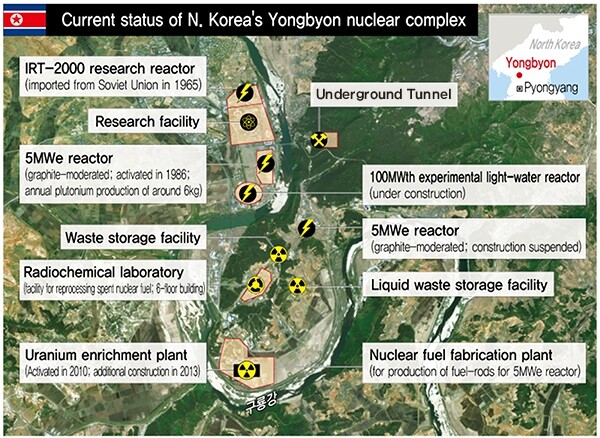hankyoreh
Links to other country sites 다른 나라 사이트 링크
N. Korea appears to have restarted Yongbyon nuclear reactor

The International Atomic Energy Agency (IAEA) detected signs that North Korea has resumed operations at its Yongbyon nuclear facility.
In a report titled “Application of Safeguards in the Democratic People’s Republic of Korea” posted to its website on Friday, the IAEA observed that “since early July 2021, there have been indications, including the discharge of cooling water, consistent with the operation” of the 5MWe reactor at Yongbyon.
This means that signs of renewed operation have been detected in the reactor, which had been offline since December 2018. A graphite-moderated reactor that first went into operation in 1986, the 5MWe reactor at Yongbyon could reportedly be used to produce around 6 kilograms of plutonium per year through reprocessing of the spent nuclear fuel that emerges from it.
The IAEA also said a steam plant serving the Radiochemical Laboratory at Yongbyon — a facility used for reprocessing of spent fuel — had been in operation for a roughly five-month period from mid-February to early July this year.
“The duration of the operation of the steam plant and Radiochemical Laboratory in 2021 is significantly longer than that observed in the past during possible waste treatment or maintenance activities,” it noted.
“In 2003, 2005, and 2009, the DPRK announced that it had conducted reprocessing campaigns at the Radiochemical Laboratory, each of which had lasted approximately five months,” it added, hinting at the possibility that North Korea may have extracted plutonium from spent nuclear fuel.
The report also said ongoing activities such as internal construction were being detected at the Kangson complex near Pyongyang.
Last year, the IAEA confirmed that the Kangson facility was connected with nuclear activities. Kangson is also the site identified by the administration of former US President Donald Trump as the location of secret North Korean nuclear facilities.
In its report, the IAEA said that the “new indications of the operation of the 5MW(e) reactor and the Radiochemical Laboratory are deeply troubling,” adding that the continuation of North Korea’s nuclear program “is a clear violation of relevant UN Security Council resolutions and is deeply regrettable.”
But the agency also noted that it cannot confirm the nature or aim of the activities at the Yongbyon facility in North Korea without actual access to it.
The report was released ahead of a 65th IAEA General Conference set to take place in September. The agency also reported signs of renewed activity in an annual report ahead of its 63rd General Conference two years ago.
Commenting on the report, a South Korean Ministry of Foreign Affairs official said Monday that authorities in Seoul and Washington were “closely cooperating to ascertain [activities at] North Korea’s nuclear facilities.”
“There will need to be a more rigorous assessment of the precise facts,” the official said.
In the Pyongyang Joint Declaration of September 2018, North Korean leader Kim Jong-un announced plans for the conditional dismantling of the Yongbyon nuclear facility. At a second North Korea-US summit in Hanoi in February 2019, the North Korean side indicated its willingness to permanently dismantle the facility, contingent on the lifting of some of the sanctions currently in place.
But Trump rejected the proposal, and the summit ended up collapsing without any agreement being reached.
By Kim Ji-eun, staff reporter
Please direct comments or questions to [english@hani.co.kr]

Editorial・opinion
![[Editorial] Penalties for airing allegations against Korea’s first lady endanger free press [Editorial] Penalties for airing allegations against Korea’s first lady endanger free press](https://flexible.img.hani.co.kr/flexible/normal/500/300/imgdb/original/2024/0502/1817146398095106.jpg) [Editorial] Penalties for airing allegations against Korea’s first lady endanger free press
[Editorial] Penalties for airing allegations against Korea’s first lady endanger free press![[Editorial] Yoon must halt procurement of SM-3 interceptor missiles [Editorial] Yoon must halt procurement of SM-3 interceptor missiles](https://flexible.img.hani.co.kr/flexible/normal/500/300/imgdb/child/2024/0501/17145495551605_1717145495195344.jpg) [Editorial] Yoon must halt procurement of SM-3 interceptor missiles
[Editorial] Yoon must halt procurement of SM-3 interceptor missiles- [Guest essay] Maybe Korea’s rapid population decline is an opportunity, not a crisis
- [Column] Can Yoon steer diplomacy with Russia, China back on track?
- [Column] Season 2 of special prosecutor probe may be coming to Korea soon
- [Column] Park Geun-hye déjà vu in Yoon Suk-yeol
- [Editorial] New weight of N. Korea’s nuclear threats makes dialogue all the more urgent
- [Guest essay] The real reason Korea’s new right wants to dub Rhee a founding father
- [Column] ‘Choson’: Is it time we start referring to N. Korea in its own terms?
- [Editorial] Japan’s rewriting of history with Korea has gone too far
Most viewed articles
- 11 in 3 S. Korean security experts support nuclear armament, CSIS finds
- 2Months and months of overdue wages are pushing migrant workers in Korea into debt
- 3Bills for Itaewon crush inquiry, special counsel probe into Marine’s death pass National Assembly
- 4[Reporter’s notebook] In Min’s world, she’s the artist — and NewJeans is her art
- 5[Editorial] Penalties for airing allegations against Korea’s first lady endanger free press
- 6S. Korean Defense Ministry rejects petition from Vietnam War civilian massacre survivors
- 7[Column] Can Yoon steer diplomacy with Russia, China back on track?
- 8[Reportage] A petition of tears by victims of civilian massacres during Vietnam War
- 9Civic groups demand S. Korean government take responsibility for Vietnam War civilian massacres
- 10Another court rules NIS to release data on Vietnam War civilian massacres